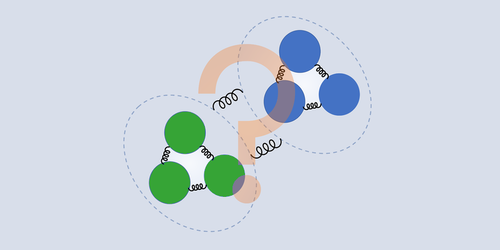• Physics 17, s37
A signal from the decay products of a meson—a quark and an antiquark—comes from two subatomic particles and not one, as previously thought.
BESIII Collaboration/T. Chen
High-energy collision experiments have helped particle physicists understand many aspects of the behavior of quarks—the subatomic building blocks of protons and neutrons. For example, during the decay of quark conglomerations, researchers have observed the brief appearances of exotic subatomic particles, such as tetraquarks or loosely bound mesons. These exotic particles appear as resonance peaks in the mass spectra of the debris of electron–positron collision experiments. A decade ago, the BESIII Collaboration at the Beijing Electron Positron Collider observed one such peak [1]. The collaboration has now confirmed the existence of that peak [2]. But the new data and analysis reveal that the previously observed peak is actually two peaks, suggesting the existence of a new exotic particle.
In 2013 the BESIII Collaboration found a resonance peak while monitoring a decay process of a quark–antiquark particle known as the J/ meson. That resonance peak was labeled X(1840); the “X” indicates that the particle producing the peak is unknown and the “1840” refers to the estimated mass of the particle in units of MeV/c2.
The researchers have now analyzed a dataset that includes 50 times more decay events than the previous one. The analysis of the larger dataset reveals a small spur—a lower secondary peak—on the left side of the main peak, a sign that it contains the signals of two particles and not one. Fitting the data, the researchers find two overlapping resonance peaks that they label X(1840) and X(1880).
This finding marks the first observation of X(1880). (The observation has a statistical significance greater than .) Learning about the behavior of particles in this mass regime is important for understanding the bound states of protons and other particles with similar masses. The finding also provides new information for searches for hypothetical exotic particles, such as glueballs (composite particles made of gluons).
–Rachel Berkowitz
Rachel Berkowitz is a Corresponding Editor for Physics Magazine based in Vancouver, Canada.
References
- M. Ablikim et al. (BESIII Collaboration), “Observation of a structure at 1.84 GeV/c2 decays in the 3 mass spectrum in J3 decays,” Phys. Rev. D 88, 091502 (2013).
- M. Ablikim et al. (BESIII Collaboration), “Observation of the anomalous shape of X(1840) in J3 indicating a second resonance near threshold,” Phys. Rev. Lett. 132, 151901 (2024).




